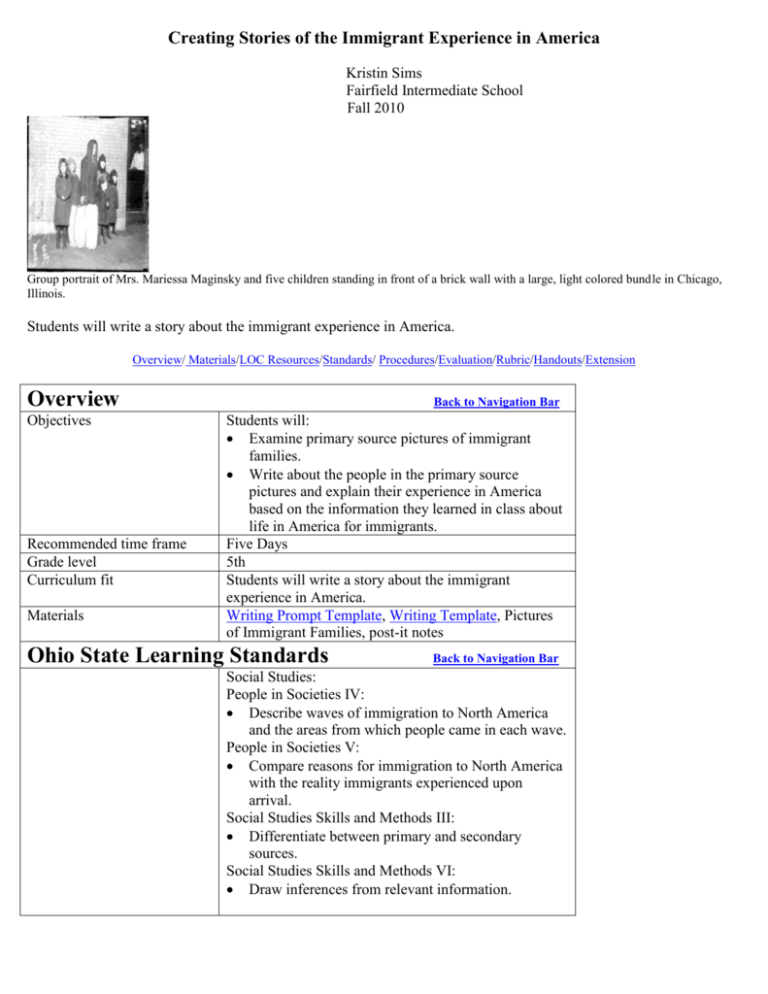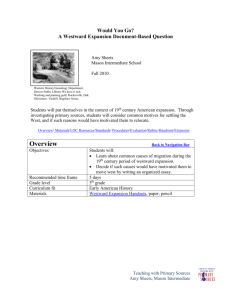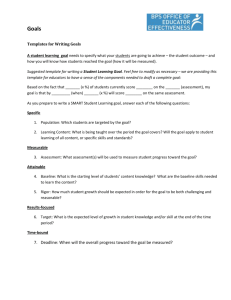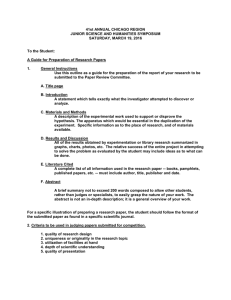Creating Stories of the Immigrant Experience
advertisement

Creating Stories of the Immigrant Experience in America Kristin Sims Fairfield Intermediate School Fall 2010 Group portrait of Mrs. Mariessa Maginsky and five children standing in front of a brick wall with a large, light colored bundle in Chicago, Illinois. Students will write a story about the immigrant experience in America. Overview/ Materials/LOC Resources/Standards/ Procedures/Evaluation/Rubric/Handouts/Extension Overview Objectives Recommended time frame Grade level Curriculum fit Materials Back to Navigation Bar Students will: Examine primary source pictures of immigrant families. Write about the people in the primary source pictures and explain their experience in America based on the information they learned in class about life in America for immigrants. Five Days 5th Students will write a story about the immigrant experience in America. Writing Prompt Template, Writing Template, Pictures of Immigrant Families, post-it notes Ohio State Learning Standards Back to Navigation Bar Social Studies: People in Societies IV: Describe waves of immigration to North America and the areas from which people came in each wave. People in Societies V: Compare reasons for immigration to North America with the reality immigrants experienced upon arrival. Social Studies Skills and Methods III: Differentiate between primary and secondary sources. Social Studies Skills and Methods VI: Draw inferences from relevant information. Procedures Back to Navigation Bar Day One: The students will be learning about immigrants who came to America. The teacher will place four pictures of immigrant families in various places on the walls of the classroom. The teacher will instruct the students to have a silent discussion about the pictures they see. The silent discussion will consist of students each having five post-its. On the post-its, the students will write their thoughts about the picture. They may write who they think the people are, where they are from, how they may be feeling as they came to America. The goal is that no verbal discussion is occurring at this time. The students are to write their own thoughts. After all students have attached a post-it near each of the pictures, the teacher will go around and just read the words on the post-its as students sit at their seats and listen. On the fifth post-it the students are to write one or two lines or words that they hear the teacher say as she reads the comments. The students are to take note as to which picture the comment they wrote down was about. The students will then share these comments with the class once more. This is just to get the students listening to what their classmates are saying. Day Two: The students will be writing a story about one of the four pictures that they wrote comments about in class the day before. They may use their classmate’s comments and ideas as a guide as well as information they have been learning in class about the immigrant experience in America. The students will use the Writing Prompt Template. In the writing assignment the students must give the people in the picture an identity, they must tell what life is like for them in America, how they are feeling, what kind of jobs they have in America, how are they treated by others. They are to take this information that they have learned in class and write a story about the picture they choose. They must write a five paragraph story using the writing prompt template to organize their thoughts. Day Three: The students will continue to work on their stories in class, they may have teacher assistance if needed. Day Four: The students will have their paper proofread and edited by the teacher and other students and begin to write their final copy on the second Writing Template. Day Five: Students will share their story aloud in class. While students are sharing their stories, other students will write positive comments on post-its about what the student has written. Evaluation Back to Navigation Bar The students will be evaluated on their writing assignment, see rubric attached. Also, the students will be evaluated on their participation in the silent discussion prior to the writing assignment. Extension Back to Navigation Bar Students may research their own heritage and create their own family tree to see where their ancestors immigrated from. They may even find pictures of family members and write their story based upon the people in their picture and use the information they find from the research to write their story. Primary Resources from the Library of Congress Back to Navigation Bar IMAGE DESCRIPTION CITATION URL Group portrait of Mrs. Mariessa Maginsky and five children standing in front of a brick wall with a large, light colored bundle in Chicago, Illinois. An African American man is visible through the window glass to the right. Text on the image reads from Russia. Group portrait of Joseph Carsello and family, involved in a bomb explosion in their home at 846 South Miller Street. in the Near West Side community area of Chicago, Illinois. Left to right are John, Domenica (mother), James (baby), Joseph (father), Florence, and Tony (standing). The family survived the explosion with minimum injuries, although much damage was done to the home and attached family store. Image of two boy scouts talking to two immigrant boys in the Italian district in Chicago, Illinois. The scouts were trying to recruit them for the Boy Scouts of America. DN-0069732, Chicago Daily News negatives collection, Chicago History Museum. http://memory.loc.gov /cgibin/query/r?ammem/c dn:@field(NUMBER +@band(ichicdn+n06 9732)) DN-0063999, Chicago Daily News negatives collection, Chicago History Museum. http://memory.loc.gov /cgibin/query/r?ammem/c dn:@field(NUMBER +@band(ichicdn+n06 3999)) DN-0064067, Chicago Daily News negatives collection, Chicago History Museum http://memory.loc.gov /cgibin/query/r?ammem/c dn:@field(NUMBER +@band(ichicdn+n06 4067)) A.J. Smith in front of their house near Jefferson, Custer County, Nebraska. Nebraska State Historical Society, [Digital ID, e.g., nbhips 12036] http://memory.loc.gov /cgibin/query/r?ammem/p sbib:@field(DOCID+ @lit(p10363)) Rubric Back to Navigation Bar Name: _______________________________________________ Date: ________________________________________________ Immigration Writing Assignment Rubric Categories Strong Levels (Criteria) Developing Not There Yet Points 3 2 1 -clear and focused -holds attention -rich with details and anecdotes -fresh, original treatment of ideas -easy to understand -adequate but mundane treatment of ideas -some attempt at support or expansion but key issues or story line not fleshed out or confused by irrelevant detail -all events assume equal importance -unclear -leaves reader hungry for details -text may be repetitious, confusing or disconnected - random thoughts -order, structure or presentation of information is compelling and moves the reader through the text -flows smoothly ORGANIZATION -inviting introduction draws reader in -satisfying conclusion -thoughtful, smooth transitions -structure moves reader through text without confusion -recognizable introduction and conclusion -connections between ideas may be unclear at times -a clear sense of direction is not evident -ideas may be strung together loosely -ineffective or nonexistent lead and conclusion -hard to determine the main point -content is accurate with what information has been learned in class about immigration. -information presented in the writing assignment is a little confusing, needs to show a better -little or no information is presented about what was learned in class about immigration. IDEAS CONTENT knowledge of information learned in class. SENTENCE FLUENCY CONVENTIONS -natural flow to sentences -sentences are well-constructed with strong and varied structure -cadence invites oral reading -text seems more pleasant and businesslike than musical -sentences are generally correct with some variety in length and structure -sentences choppy or awkward -most sentences are simple in structure and begin the same way -frequent connectives -writer demonstrates a grasp of standard writing conventions -some minor errors -reasonable control over conventions -some misspellings, errors in internal punctuation, attempted paragraphing -frequent errors in conventions may interfere with reading Rubric adapted from: Best Practices: Instructional Strategies and Techniques. Regina Public Schools, 2003. <http://www.saskschools.ca/curr_content/bestpractice/rubrics/examples.html>. Handouts Back to Navigation Bar Writing Prompt Template Writing Template









